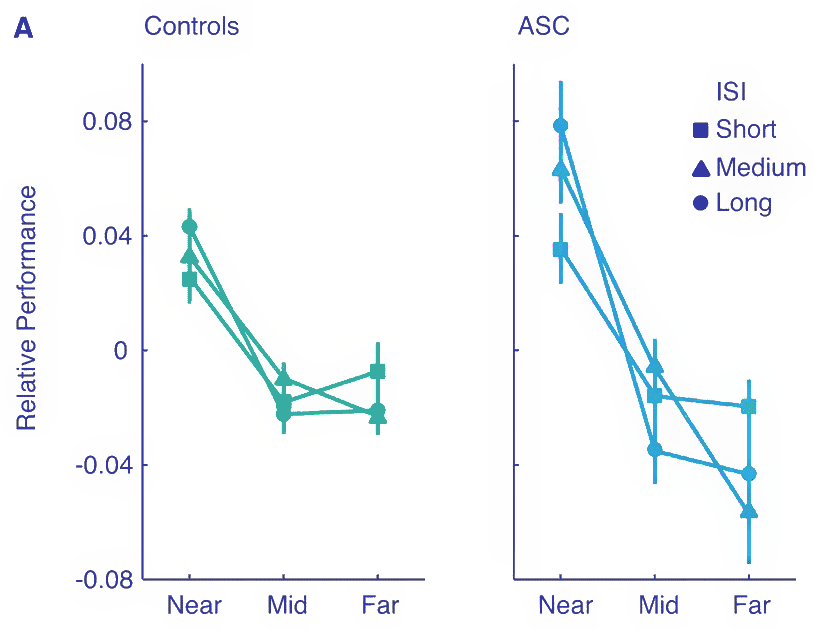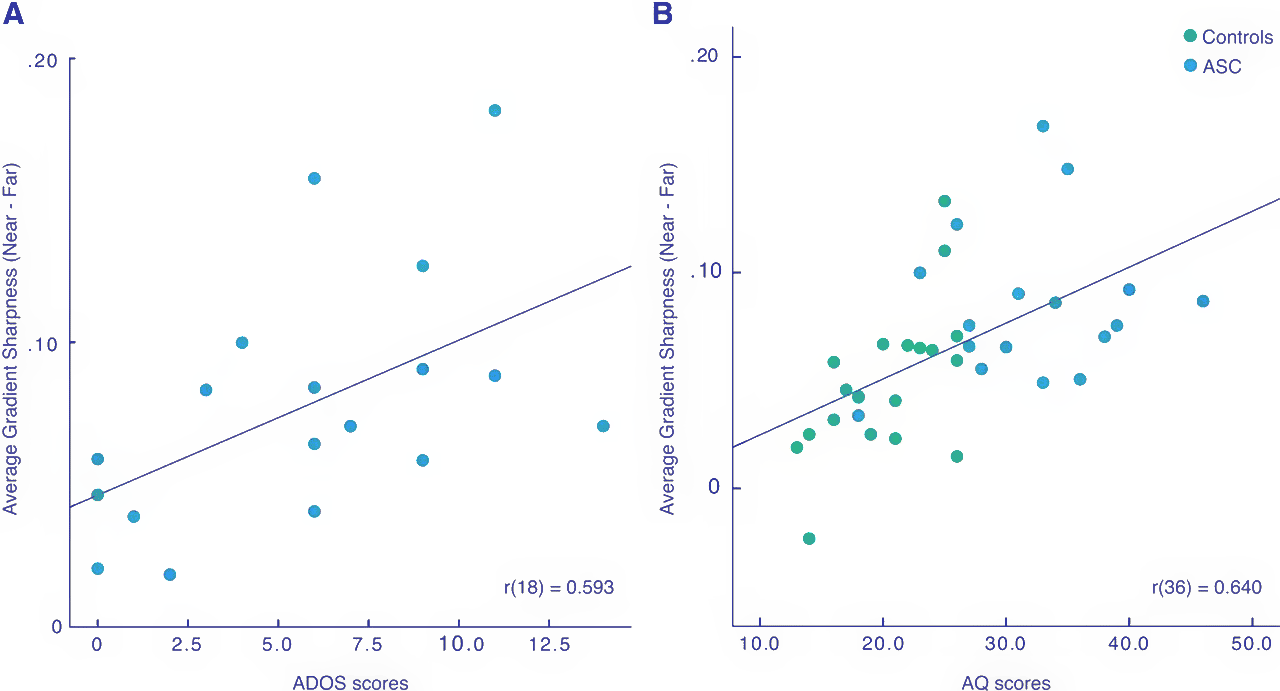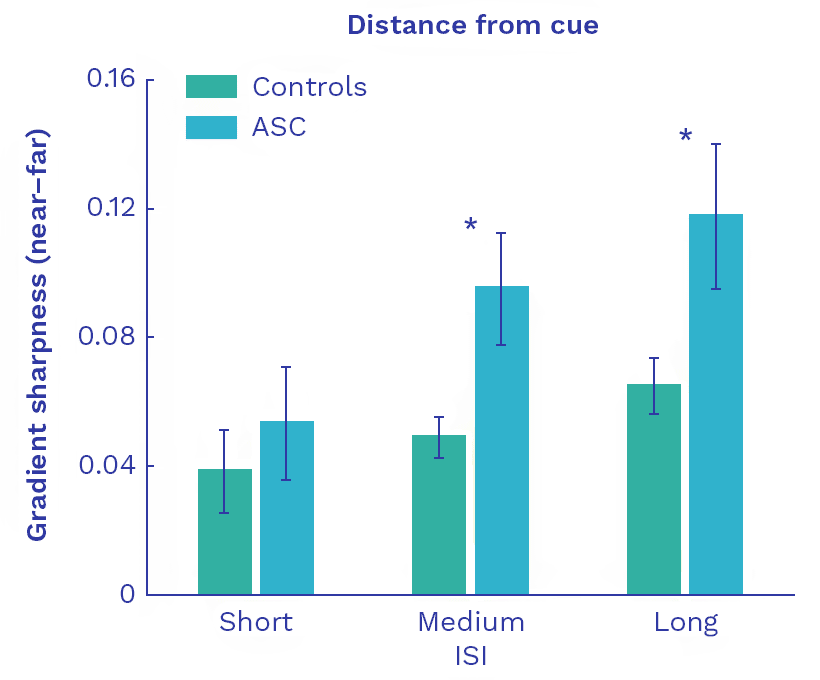Something that truly fascinated me is discovering autistic people experience tunnel vision!
Focus of attention
A study from 2013 (co-authored by Simon Baron-Cohen) indicated the focus of attention in autistic people is sharper than in matched controls.[1]Tunnel Vision: Sharper Gradient of Spatial Attention in Autism
Using a simple visual acuity task embedded in a standard cueing paradigm, we mapped the spatial and temporal gradients of attentional enhancement by varying the distance and onset time of visual targets relative to an exogenous cue, which obligatorily captures attention.[2]Tunnel Vision: Sharper Gradient of Spatial Attention in Autism
Gradient of attention
As expected, in both autistics (ASC) and controls, performance decreased with distance from the cue, which indicates the spatial gradient of attention, as you can see in the image below.

Individuals with ASC [autism spectrum conditions] demonstrated a greater fall-off in performance with distance from the cue than controls, indicating a sharper spatial gradient of attention.[3]Tunnel Vision: Sharper Gradient of Spatial Attention in Autism
These findings establish the presence of a form of “tunnel vision” in ASC, with far-reaching implications for our understanding of the social and neurobiological aspects of autism.[4]Tunnel Vision: Sharper Gradient of Spatial Attention in Autism
In other words, it seems that when autistic people look at anything, they take a lot of information in at once, but with a greater focus on the center. Although the drop-off of attention is sharper in autistic people, perception in general is still enhanced compared with neurotypicals.
A sharper gradient of attention in ASC may contribute to a robust finding in the literature: individuals with autism routinely display faster detection of targets in conjunctive visual search tasks (Plaisted et al., 1998; Joseph et al., 2009).
Sharper spatial gradients around target locations would predict less interference from distractors and quicker response times in conjunctive visual search, and efficient perception of details in visual scenes.[5]Tunnel Vision: Sharper Gradient of Spatial Attention in Autism
Autistic traits
The extent to which the person focuses on the center correlates with the extent of autistic traits, as measured by the AQ, as you can see in the image below.

This sharpness is highly correlated with the severity of autistic symptoms in ASC, as well as autistic traits across both ASC and control groups.[6]Tunnel Vision: Sharper Gradient of Spatial Attention in Autism
To make better sense of how this spatial gradient and extent of autism symptoms compare, and to estimate the overall sharpness of the attention gradient in each participant, researchers computed gradient difference scores for each interstimulus interval (ISI) separately (near–far distance).

Personal experience
I guess I shouldn’t be too surprised by the research. As a kid, I would mostly either read or draw, and when I drew, I would put in a lot of detail—to a degree not common at that age. I would draw a forest, and draw all the trees, branches, twigs, leafs, squirrels, and whatever else I imagined that forest to be and contain. I lived next to a forest, so I was familiar with all the details therein.
But I never looked at the forest from a distance. To me, it was just a blur, and I thought everyone saw the world this way. I had the inclination to look at everything from really up close, and inspect all the fine details. I loved details then, and still do. I think it’s this tunnel vision and focus on details that, metaphorically speaking, made me draw the trees rather than the forest. It was only through the accumulation of details that it became a forest.
It wasn’t until I was 12 that I realized that I am actually nearsighted, too. No wonder everything from a distance was blurry. But my myopia made it possible to see things from a much shorter distance at greater detail, whereas conventionally people wouldn’t be able to focus at such a short distance. I think my nearsightedness created some distance between me and the world, as the world I knew with clarity had a radius of three meters. But when it comes to the appreciation of details, the combination of myopia and this autistic tunnel vision turned out to be a delight. Read more about myopia here:
Autism, myopia, and high IQ
So there you have it. Apparently, we focus on a smaller area and perceive it with greater clarity—the extent of which depending on the extent of autistic traits.
Can you imagine how a neurotypical sees the world? If you are neurotypical, you very well can, but then you might have difficulty imagining how autistic people see the world.
Comments
Let us know what you think!